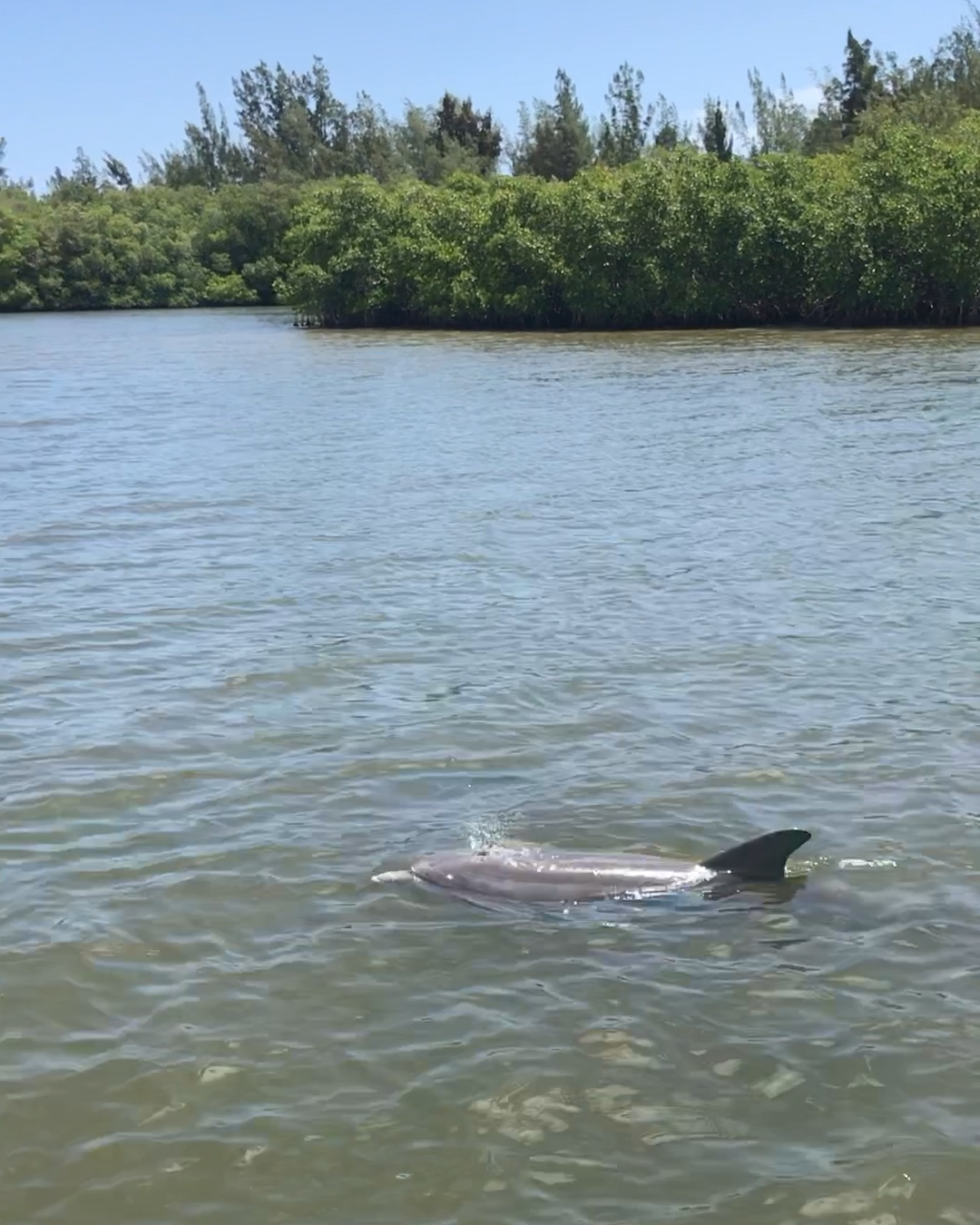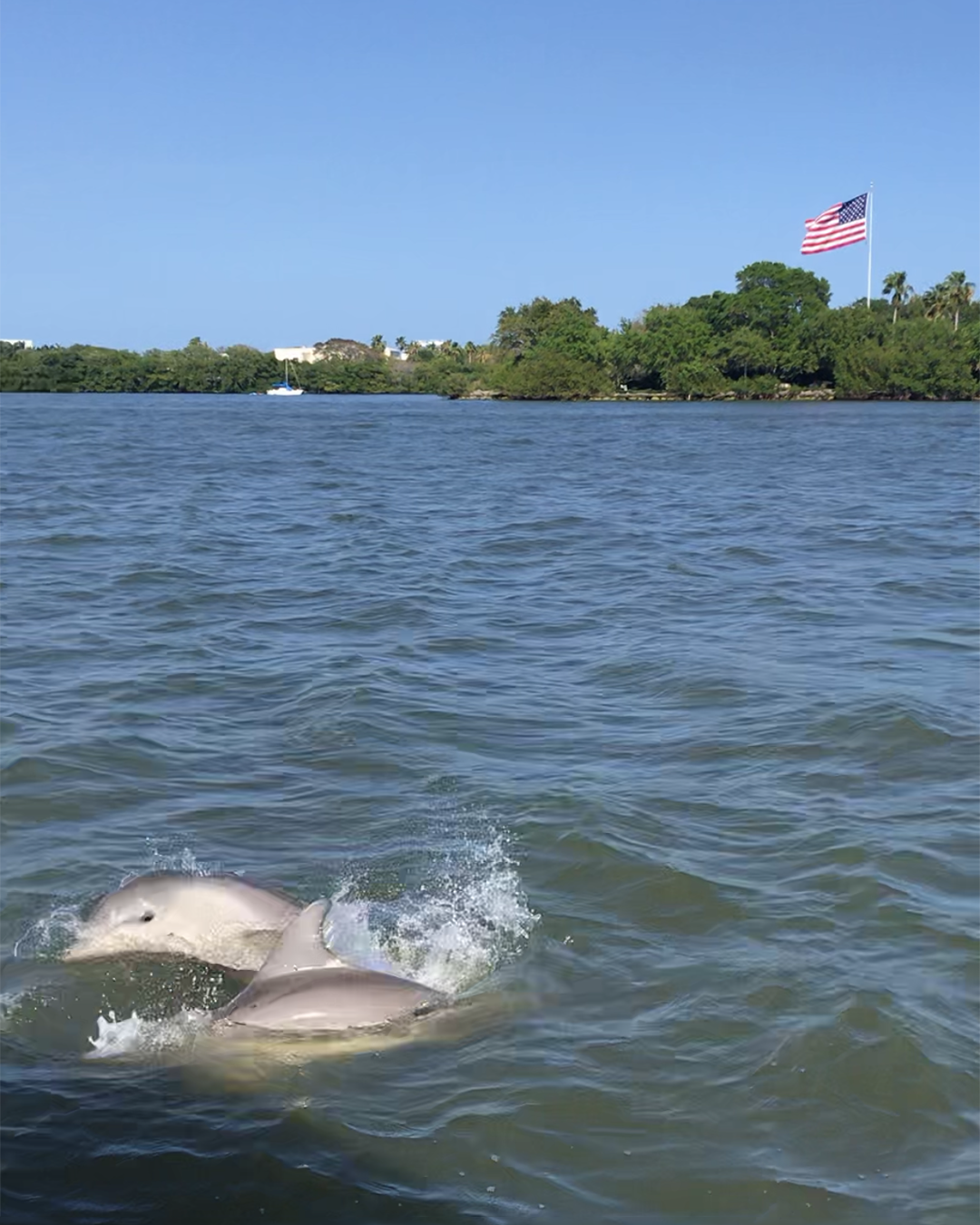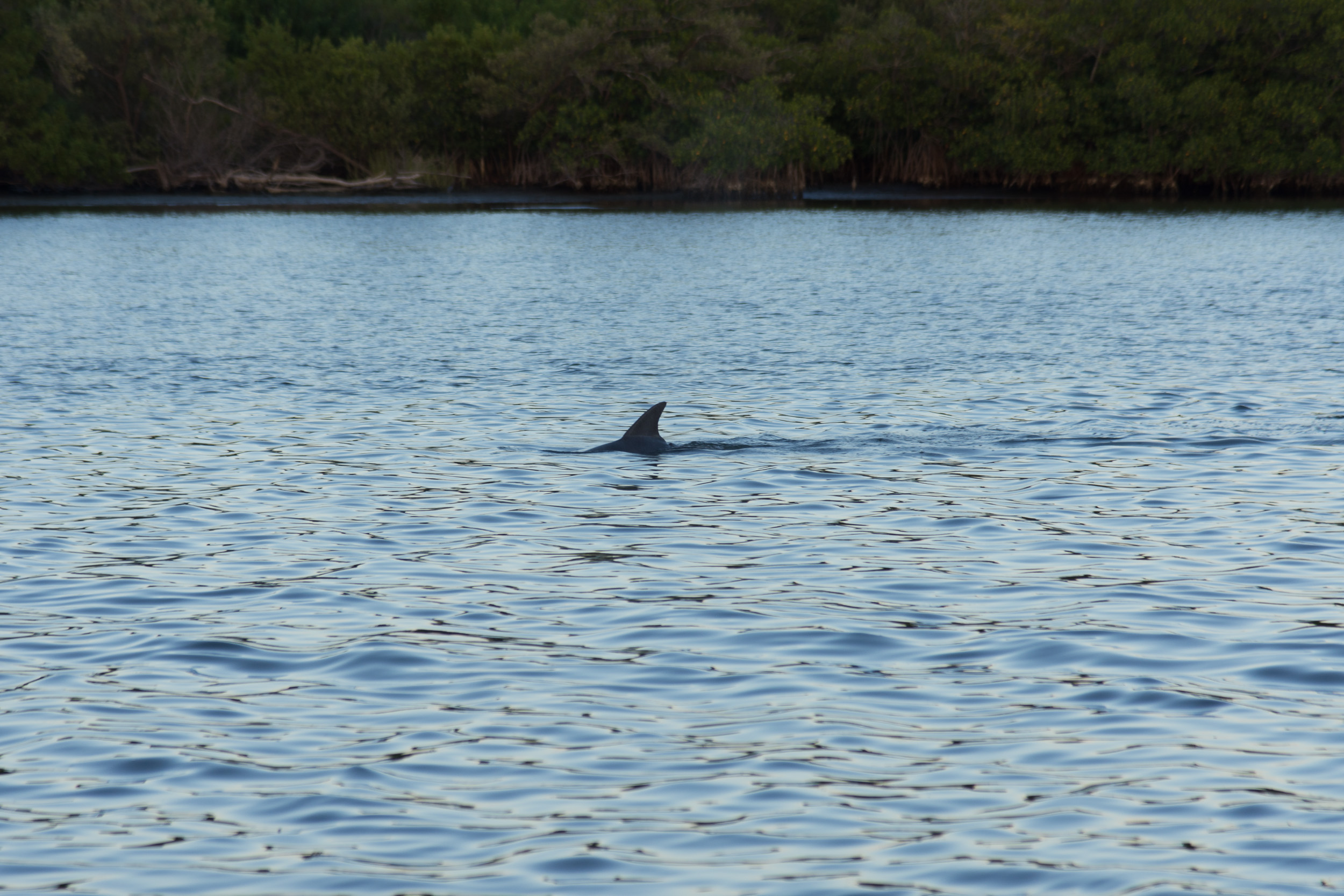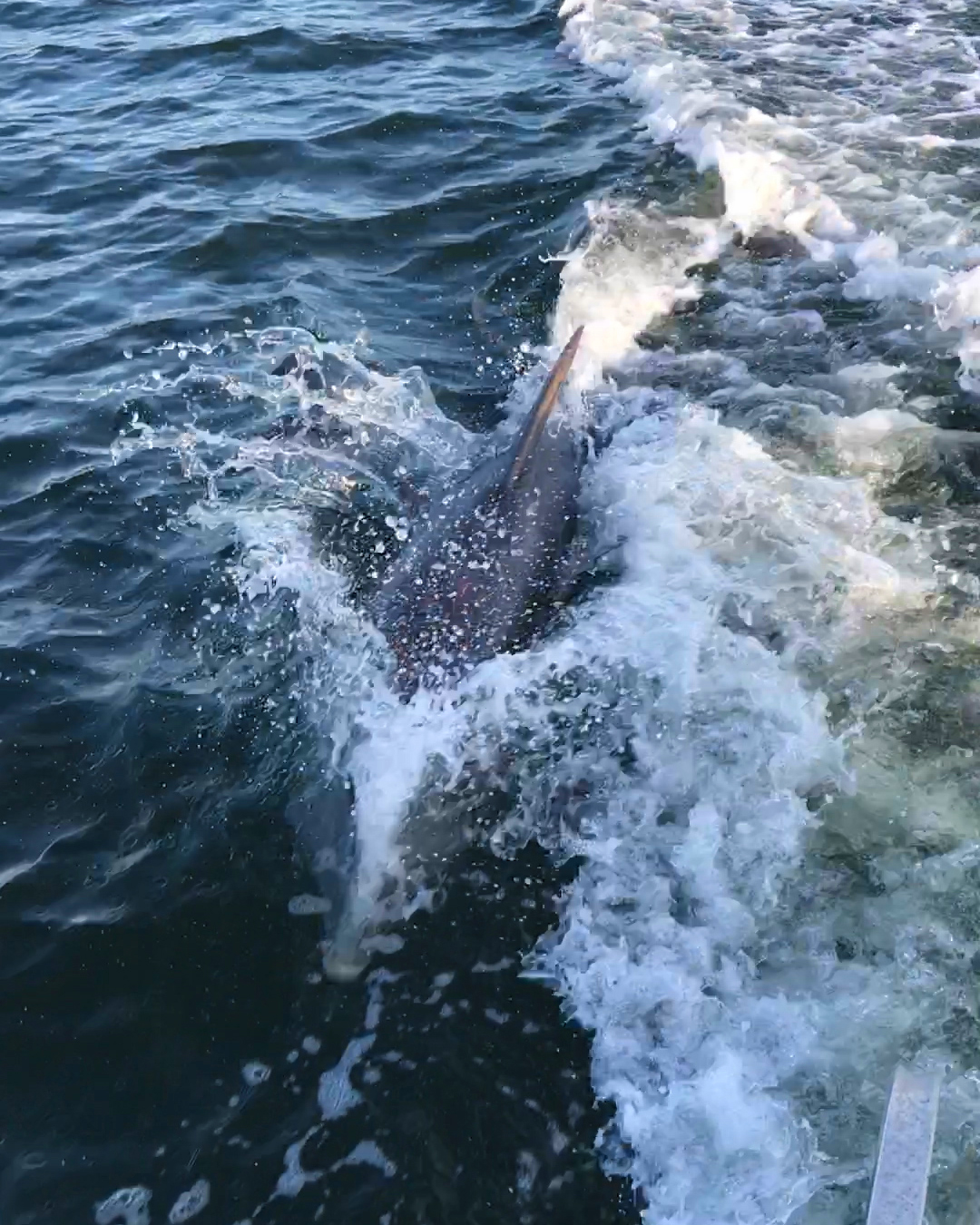
Did you know that the Indian River Lagoon is home to over 1,000 dolphins?
Scientists previously estimated that only a few hundred dolphins resided in our 156-mile stretch of the Intracoastal Waterway. Then in 2016 and 2017, a team of researchers embarked on 135 surveys to determine the exact number.
After collecting over 150,000 images of dorsal fins and analyzing them for unique marks, the researchers discovered there are at least 1,032 dolphins living in the lagoon. That’s a lot of dolphins!
In this post, we’re going to cover everything there is to know about our local flippered friends, including the best way to see them in their natural habitat.

ABOUT THE INDIAN RIVER LAGOON DOLPHINS
The lagoon dolphins are Atlantic bottlenose dolphins, which usually reside in—you guessed it—the Atlantic Ocean. Some of them settled in the Indian River Lagoon at an unknown point in history, and they haven’t left since.
The lagoon is a perfect habitat for dolphins due to its consistently warm waters and diverse ecosystem.
Curiously, this hasn’t been enough to lure in more oceanic dolphin populations. Lagoon dolphins stay in the lagoon full-time, and ocean dolphins rarely visit.
Except for a couple of behavioral quirks, lagoon dolphins are still the same as their ocean counterparts.
One way the populations differ is pod size. Ocean dolphins travel in large groups of up to 25, but our local friends prefer to keep it more personal in groups of ten or fewer.
Like all dolphins, lagoon dolphins use echolocation to hunt, and they communicate with each other through clicks, whistles, squeals, and other sounds. Each individual has a unique whistle, much like humans have distinct voices.
Adults can grow to lengths of six to twelve feet and weigh anywhere from 330 to 1,400 pounds. Despite their large size, they can swim impressively fast at up to 22mph, but they usually travel at a leisurely pace of 7mph.
Because dolphins are marine mammals, they can’t breathe underwater. Unlike humans and other land animals, dolphins must consciously choose to breathe, so you might wonder:

HOW DO DOLPHINS SLEEP?
A surprising fact about dolphins is that they don’t fully sleep.
Instead, they rest half of their brains and one eye at a time. They switch sides after about two hours. Without this unihemispheric sleep, dolphins would drown.
While dolphins rest, they can only perform a few simple maneuvers.
Sometimes they sit motionless, horizontally or vertically, near the surface of the water. Other times, they slowly swim next to another dolphin. Their open eye keeps a careful watch to avoid predators and obstacles.
And of course, they surface to breathe.
Although dolphins often rest at night, they remain active throughout all 24 hours of the day. Noticing this, marine scientists asked, “What do dolphins do while we’re asleep?”
LAGOON DOLPHINS AFTER DARK
Researchers in Indian River County were among the world’s first to start peeking into dolphins’ nighttime activities.
In 2012, local marine scientists tagged four lagoon dolphins and tracked them for four months using satellite telemetry, a technology similar to GPS. The results surprised them.
After sunset, dolphins travel all over the lagoon. They have the water primarily to themselves at night, and they seem to take full advantage of the lack of boat traffic.
All four of the dolphins seized the opportunity to safely travel through the inlets, and each of them returned by morning.
Three of the four dolphins ventured into freshwater areas, which can harm their health. But they seemed to know the risks. They swam nearly 12 miles into freshwater canals and rivers, yet they were never out of saltwater for long.
Researchers aren’t sure why local dolphins leave the lagoon at night, but they suspect it’s to access a wider variety of prey. Future studies should shed more light on these remarkable behaviors.
In the meantime, we’ll keep admiring our mysterious flippered friends.

BEST WAY TO SEE DOLPHINS IN VERO BEACH, FL
Many people like to dolphin-watch at parks along the Indian River Lagoon. Some popular choices are Riverside Park, Veterans Memorial Island Sanctuary, and Royal Palm Pointe Park.
The parks are scenic and great choices for a pleasant stroll, but the downside is that each park only boasts a small view of the Indian River Lagoon. Dolphins may not be there.
If your goal is to see dolphins, getting out on the water is the best way. At Vero Tackle & Watersports, you can hop aboard our tour boats and leave the dolphin tracking to us.
Our expert captains are out on the Indian River Lagoon every day, and they know the local dolphins’ latest hangout spots. It’s rare for tours to return without seeing dolphins.
DOLPHIN BOAT TOURS WITH VERO TACKLE & WATERSPORTS
We offer a few private tour options that are sure to fit any dolphin lover’s needs.
For a laidback experience perfect for the whole family, we recommend our regular tour boat, Potamoi, which features ample shade, a cooler for snacks and drinks, and kid-friendly seating.
For dolphin fans who would prefer to sip a cocktail during their tour, we recommend cruising on Tiki By The Sea, which includes bar seating, two coolers for food and drinks, color-changing LED lights, and a Bluetooth sound system for your favorite tunes.
Both tour boats can accommodate up to six guests, and each tour is 90 minutes of fun on the Indian River Lagoon.
Tour times change throughout the year. Take a look at our tour schedule to start planning your adventure:
The best times to see dolphins are in the morning, around sunset, and at dusk. As a bonus, these are also the best times to miss the afternoon heat during the summer months.
For an unforgettable dolphin-watching experience, give us a call or book online. See you on the water!
Author: Lauren Hamers
